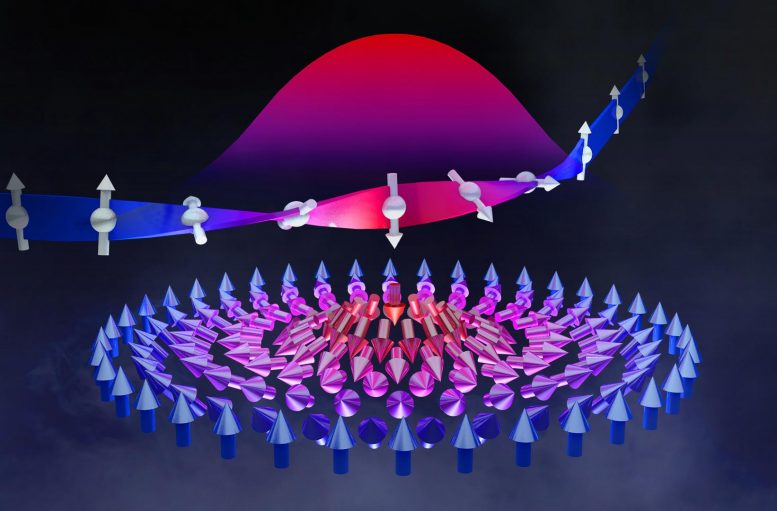
The layering of crystals into a superlattice yields a nanoscale magnetic structure of twisting, swirling spin orientations, shown from red to blue, that deflect electrons, shown as white dots. Credit: Adam Malin/ORNL, U.S. Dept. of Energy
Scientists discovered a strategy for layering dissimilar crystals with atomic precision to control the size of resulting magnetic quasi-particles called skyrmions. This approach could advance high-density data storage and quantum magnets for quantum information science.
In typical ferromagnets, magnetic spins align up or down. Yet in skyrmions, they twist and swirl, forming unique shapes like petite porcupines or tiny tornadoes.
The tiny intertwined magnetic structures could innovate high-density data storage, for which size does matter and must be small. The Oak Ridge National Laboratory-led project produced skyrmions as small as 10 nanometers – 10,000 times thinner than a human hair.
“The way we design and synthesize the superlattice creates the atomic-scale magnetic interactions responsible for twisting the spins,” said physicist Elizabeth Skoropata, who co-led the study with John Nichols, both formerly of ORNL.
ORNL’s Ho Nyung Lee added, “Our finding demonstrates how to precisely engineer interfaces in oxide quantum heterostructures to create nanometer-sized skyrmions.”
Reference: “Interfacial tuning of chiral magnetic interactions for large topological Hall effects in LaMnO3/SrIrO3 heterostructures” by Elizabeth Skoropata, John Nichols, Jong Mok Ok, Rajesh V. Chopdekar, Eun Sang Choi, Ankur Rastogi, Changhee Sohn, Xiang Gao, Sangmoon Yoon, Thomas Farmer, Ryan D. Desautels, Yongseong Choi, Daniel Haskel, John W. Freeland, Satoshi Okamoto, Matthew Brahlek and Ho Nyung Lee, 3 July 2020, Science Advances.DOI: 10.1126/sciadv.aaz3902